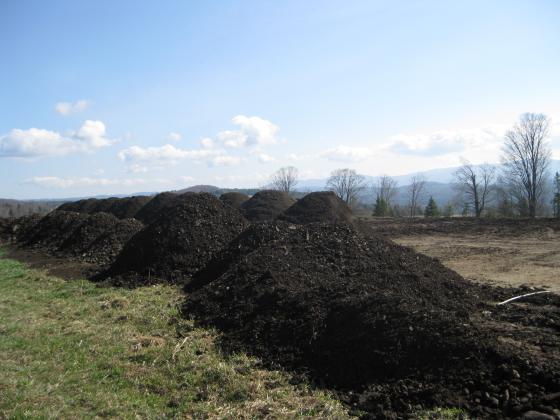Posted January 8, 2020 at 03:27pm by Bonnie Paris
Kingdom View Compost Completes SARE Research on ASP Composting

Kingdom View Compost is located on Tamarlane Farm in Lyndonville, VT. Kingdom View Compost was created in 2005. In partnership with our solid waste district and a local non-profit, we collect food scraps from area food scrap generators such schools, restaurants, etc. These food scraps are mixed with wood chips and manure on our certified organic dairy farm to produce our valuable fertilizer. Over the years, the local program has grown from around 2-3 Tons/Week of scraps to around 12 Tons/Week.
During the Summer months of 2019, Kingdom View Compost (KVC) built four research compost piles- two piles of which were composted using our farm-built ASP system, and two piles which were composted using our normal Turned Windrow system. All piles were blended using the same feedstock materials- 50% wood chips, 25% food scraps, and 25% dairy manure/bedding. In order to allow adequate time for composting, the first ASP pile was built with the goal of an 8-week residency in the ASP system. The first turned windrow pile (TW1) was built in the following two weeks, and then managed by turning approximately weekly for 1 month. Following this, the next side by-side ASP and turned piles were constructed and monitored. The summer trials lasted from May 1 – Sept 9, 2019.
For the purposes of analyzing the efficiency of the ASP system relative to the current turned windrow system, we set out to measure the following:
- Time required for compost to meet the time/temperature requirements as defined by the National Organic Program, as well as the difference in time required for compost to finish active composting and begin curing.
- Space used to manage the compost piles, measured as square ft. per cubic yard.
- Labor inputs required to produce compost in both types of systems, measured in both person-hours and tractor hours.
- Differences in quality of finished compost between the two types of composting systems. Compost quality was assessed by observing the stage of decomposition of the side-by-side piles, as well as smells, moisture content, etc. These observations were recorded in monitoring notes, and through photo documentation. We had originally planned to send samples of the finished compost for nutrient analysis, but by this stage in our process, the project budget no longer allowed for lab testing.
Based on the temperatures that we were able to record, as well as our own sensory observations, we believe that our pilot ASP system does indeed make compost faster and on 1/3 of the footprint of the turned windrow system as implemented at Kingdom View Compost.
This is attributable to the highly aerobic environment in the compost pile created by an ASP system. The available oxygen to meet the biological oxygen demand (BOD) in a turned windrow compost pile begins to deplete in a matter of hours after a turning. In a properly sized ASP system with correct fan settings, the oxygen demand is met more consistently by the forced air from the fan. The higher temperatures in the ASP piles indicate greater aerobic microbial activity, which may be attributed to the replenished oxygen from the ASP.
The final report will be available on the NESARE website later in January.
